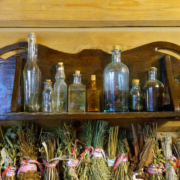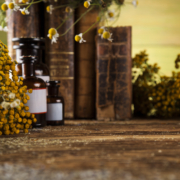Re-localization of Herbal Medicine in British Columbia
Lackluster Herbal Medicine
The herbal medicine world is much bigger than we think. Most often herbs are purchased solely at grocery stores in pre-boxed beautifully designed containers to attract the eye. It is common knowledge at herbal colleges that the medicinal properties in the Chamomile we buy in pre-boxed with pre-bagged tea bags is already extracted from its medicinal properties before it even hits our teacup. What is rumoured to happen is the powerful blue chamzulene essential oil that is in chamomile is first steam distilled and extracted and then the chamomile tea is put into a bag for us to drink at a later time. This is because blue chamazulene is very expensive and also well known for its healing properties.
Where do our Plants Come From?
It is wonderful coming across herbal medicine in any form. It is also important to know how to source the highest quality most sustainable herbal medicine products. A lot of are herbs are conventionally grown therefore the impact on the natural sources of these plants are minimal. Where these plants come from is a different story. Just off the top of my head thinking about purchase orders I do I would say anywhere from 60% all the way up to 80% of dry herbs that I bulk purchase comes from either Eastern Europe or China. This is because the cost of growing herbs is more affordable in those regions. Here in Canada water, land and nutrients for the plants are all much more expensive for us to purchase.
How can we Bring Back the Medicine?
I think it’s great that the herbal medicine world can help support these communities worldwide but I also think it’s important we support our local community and become self-sustainable. Due to the “new” “pandemic” I spent some time looking into British Columbia’s growing schedule and its ability to be self-sustainable. From this brief information gathered from government research the only product we produce that we have in abundance is fruit. Everything else we grow is only a percentage of what our community needs therefore we have to import from other provinces other countries around the world.
Our Vision:
The vision of Errant Empire Herbal Medicine is to be one of many partners in the community to help re-localized herbal medicine. We have already established relationships with multiple farmers and are in the process of connecting with local wild-crafters to help sustainably sourced our dispensary.
As I was designing which herbs we will carry in our dispensary I began to create a list of which plants we can source locally weather through cultivation or wildcrafting. I was shocked to realize that the list kept growing and growing and growing. We are blessed to live in a Garden of Eden on Vancouver Island where the temperatures and the climate are perfect for a diversity of plant growth.
Herbs that can be Wild-crafted or Cultivated in BC
Below is a short list of some of the herbs that we can Source locally and or grow fairly simply:
- Hawthorne Leaf, flower, Berry
- Nettle Leaf and Root
- Ginger
- Turkey Tail Mushroom
- Rosebud’s
- Rose Hips
- Rosemary
- Self-heal
- Wild Lettuce
- Oregon Grape Root
- Old Man’s Beard
- Plantain
- Cleavers
- Devils Club (ceremonial plant)
- Calendula
- Gumweed
- California Poppy
- St. John’s Wort
- Dandelion Leaf and Root
- Burdock
- Catnip
- Lemon Balm
- And the list will go on…
Further Thought..
Something interesting when talking about some of these local herbs that I listed is that quite often Plantain and Dandelion root are sourced all the way from Eastern Europe when they grow abundantly here. Dandelion is in my herb garden, as well as in my front yard grass. This year I have spent three different occasions getting the “weeds” out of my grass and trying to contain them in the garden.
The World is Shifting
The world is shifting and we as herbalists need to shift with it. Our tinctures for the time being are still sourced from our wonderful partners in the United Kingdom because they’ve perfected the process. At Errant Empire we are actively moving in the direction of developing our own sustainably-sourced high-potency alcohol tincture extracts. Stay tuned…
Our new partner in the Kootenays will be providing the dispensary with close to 10 fresh herbs so that we can begin this process of re-localizing herbal medicine and making it more sustainable and affordable.
Call to Action
We want to be a partner with in a community of farmers, wild-crafters and other herbalist to uplift the Western herbal tradition here in British Columbia. If this is something that calls to you, please do not hesitate to reach out and let us know your plans and thoughts and we can connect and make this vision happen for the whole herbal industry.
We are an herbal medicine dispensary on Vancouver Island with over 150 plants in our dispensary. All of our dried herbs are sourced locally or regionally sourced. If we can’t find them in this capacity, we support other local dispensaries and purchase from them. We are in the process of designing our retail store that will have our dispensary three clinic rooms and other complementary and alternative remedies.
Please feel free to reach out if you have any questions or want to connect. Whether you’re new to herbal medicine or a fellow herbalist we love to connect. Thank you for reading our blog and we look forward to starting the conversation.
David is a practicing Medical Herbalist living on Vancouver Island in British Columbia. The herbal dispensary he works with is stocked with therapeutic tinctures that are among the highest strength in the industry. The dry herbs he uses are all locally or regionally sustainably sourced in North America. If the herb is not accessible locally or regionally the dispensary supports other local distributors in Victoria, British Columbia. This is the vision of Errant Empire Herbal Medicine to re-localize herbal medicine.
If you are interested in learning about how to understand the strength of tinctures or would like to talk one-on-one with a Medical Herbalist, please feel free to reach out to herbalist@errantherbal.com or see our BLOGs and pages below. Thank you for reading and take care.

